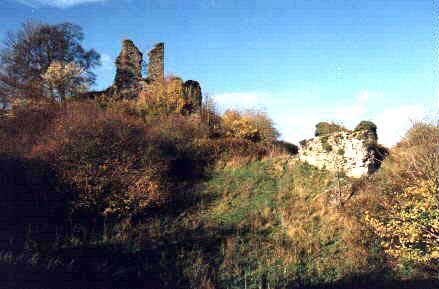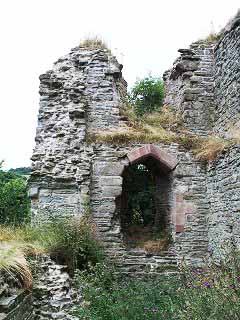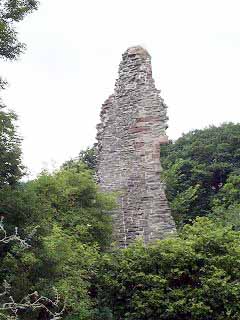Wigmore
Wigmore castle stands in the north-west corner of Herefordshire a few miles from the current boundary between England and Wales. This, one of the largest of castles, was founded by Earl William Fitz Osbern in the period between his being made earl of Hereford soon after Christmas 1066 and his death at the battle of Cassel in Flanders on 22 February 1071. He also founded the castles of Berkeley, Clifford, Ewias Harold and Monmouth. Wigmore castle was built over the lands of two Saxons who lost their lands during the Norman conquest of England. After Earl William's death his son, Roger of Breteuil, was imprisoned for life in 1075 after a failed rebellion against William the Conqueror (1066-87). However, according to the Mortimer Chronicle, it was Ralph Mortimer who seized Wigmore castle from the Saxon known as Edric the Wild, or Edric Silvaticus. This might mean that Edric was holding Wigmore for the rebel earl of Hereford when Ralph captured it and was awarded it by William I. This certainly fits the known evidence of their careers.

In 1155 the new King Henry II demanded some royal fortresses back from Earl Roger of Hereford, namely Hereford itself, and Hugh Mortimer, Bridgnorth. Insulted, both barons rebelled. King Henry moved against them and Earl Roger capitulated to the king and then helped the monarch against his erstwhile ally, Hugh Mortimer. The king with the feudal might of England attacked Mortimer and for 3 months besieged his castles of Cleobury Mortimer, Bridgnorth and Wigmore. Cleobury fell, but Wigmore and Bridgnorth held out. On 7 July 1155, king and baron met at Bridgnorth and agreed terms. From now on Hugh Mortimer was to hold his remaining lands as a super baron. Not only were his lands to be largely free of royal interference Hugh was also to be free of taxation. However, the die had been cast in regard to the two mens' relationship and Hugh Mortimer and Henry Plantagenet were never to be close associates. Mortimer surrendered Bridgnorth and Bishop's Castle in Shropshire into the king's hands.
During 1173 and 1174 Hugh's son, Roger Mortimer (d.1214) was prominent in crushing the Young King's rebellion in England and Wales. However, he fell foul of the king on 22 September 1179 when he murdered the Welsh King Cadwallon ap Madog in the neighbouring principality of Elfael. Cadwallon's court poet, Cynddelw, recorded the king's death stating:
- My skill has brought me importunity,
- Hath brought me wealth...
- A gilded saddle, splendid, proudly gay,
- From the majestic knight of coursers fleet.
- Taken today! Tis this that maddens me -
- For his distracting loss I smart with pain.
- Defending Elfael, when, in Autumn, he
- Drenched with his blood his country’s gory soil,
- None greeted him with deferential gift;
- They came to greet him, but they spared him not;
- Fell back each coward then, till he was slain,
- Rushed on each hero then, till he was felt;
- Head over heels the stumbling chieftains fell,
- While kin from kin sought succour every one.
- While lived the country’s high-escorted king,
- Of gain and wealth they found the daily use,
- High-trotting steeds, tall flanked and grey were theirs
- A wolf was he, the root of manly strength,
- In fight his valiant sword-strokes, wolf-like, fell...
- His lance has memories of mourning left,
- And crimson gashes oozing out with gore.
- The fiery prince has left behind him sons,
- Themselves would leave blood-tricklings from their foes.
- Three whelps of leaders bold to thrust the spear,
- In fray of lances eager eagles three.
- Privy to conflicts three, and sword-cuts dire...
- Three native hawks, high-famed, of purest breed,
- Stout youths, who wash their cheeks from stain of war.
- Since now, by stroke of battle-axe cut down,
- Our princely lion-monarch is laid low...
After Roger Mortimer's men had killed Cadwallon with a battle-axe the king moved against him for his murder of a royal client. Roger was arrested while his men were hunted down, either being forced into outlawry, or if captured executed. Roger spent the next two years incarcerated in Winchester castle. Hugh Mortimer died, aged a little over 65, during February 1181 and the king took over Wigmore castle and imprisoned Welshmen captured there during fighting in Maelienydd. Roger was released after the disastrous battle of Dingestow in 1182 and returned to Wigmore. In 1191 he lost Wigmore castle to Chancellor William Longchamp of Wilton castle, soon to famous as the unfortunate transvestite prime minister of England.

In 1242 the 11 year old Roger Mortimer is said to have supervised the building of Cefnllys and Knucklas castles in Maelienydd while his father invaded France with King Henry III. In 1246 Ralph Mortimer died and the young Roger Mortimer fined with the king for 2,000m (£1,333 6s 8d) to have his lands despite his youthfulness. In 1256 Roger's cousin, Prince Llywelyn ap Gruffydd, rebelled against King Henry III and attacked Roger Mortimer in Rhwng Gwy a Hafren. From this point on the 2 cousins were mortal enemies, with Llywelyn defeating Roger at Cefnllys in November 1262 and chasing him back to Wigmore castle for Christmas. There 'in his compulsive and venomous anger' Roger Mortimer formed his army and beat Llywelyn's army at Abergavenny in March 1263. It was probably Mortimer who beat another of Llywelyn's armies at Clun in late April 1263, but he was badly wounded there by an arrow and his men were ignominiously expelled from Wales while civil war broke out in England, partially caused by the young Mortimer's arrogance. In April 1264 Mortimer was amongst the royalists victorious at Northampton, but decisively defeated at Lewes on 14 May 1264. During the summer and winter of 1264 Wigmore castle withstood assault although Hay on Wye and Richards Castle did not. Finally on 4 August 1265, Roger Mortimer gained his vengeance against the rebel barons when he personally dispatched Earl Simon Montfort of Leicester at the battle of Evesham by a lance thrust through the throat. The royalist barons then dismembered Montfort before sending his head and genitals to Roger's wife, Matilda Braose, as a birthday present.
Four days before Evesham, Roger had been present at the rout of the baronial army at Kenilworth where he captured the earl of Oxford and assumed his title. Roger sold the title back to Robert Vere in 1268 for 2,500m (£1,666 13s 4d). It was probably with this money that Roger rebuilt Wigmore castle as the stately pile that can be seen today.
In 1281 Roger made a private treaty with his old enemy, Prince Llywelyn ap Gruffydd whereby they agreed to support one another against all men except for the king and his brother, Earl Edmund (d.1296). This complete change of face by Roger was probably directly due to Prince Llywelyn now being an old man over 65 years of age. Mortimer was only 50. Llywelyn did not get on with his brothers, Owain, Rhodri and Dafydd and it is possible that the 2 enemies made a secret pact at Radnor castle that October that Mortimer would succeed Llywelyn. Less than 6 months later Llywelyn struck attacking the new royal castles in the Perfeddwlad at Flint and Rhuddlan. Roger Mortimer was appointed captain of the army against Llywelyn in central Wales. Previously Mortimer had been a thorn in Llywelyn's side. In 1282 he did nothing! As events moved towards a climax in Wales any Mortimer plot to seize the county was undone as Roger suddenly died 'of a bad cold' at Kingsland castle about 26 October. In December Prince Llywelyn struck, streaming back into the Mortimer country of Rhwng Gwy a Hafren. There on 10 December 1282 he was killed at dusk by the sons of Roger Mortimer and Roger's replacement as captain of the army of Montgomery, Roger Lestrange. The next dawn Llywelyn's army was routed at Llangantern and all hope for an independent Wales died. Wigmore castle then remained the caput of the Mortimer barony until they died out in 1424, although since the time of Earl Roger Mortimer (d.1330), they had tended more to the lavish palace they had created at Ludlow castle.

The Mortimers of Wigmore, 1066 to 1181. Part 1: Wigmore Castle (ISBN 1-899376-14-3) [1995] looks in detail at the first three English Mortimers, Roger, Ralph and Hugh (d.1181) and their Norman predecessors. The foundation and design of Wigmore castle by William Fitz Osbern around 1070 is examined and also the setting up of the associated castellany which later became the Mortimer honour of Wigmore. The castle is then explored and explained with many photographs taken before the recent English Heritage repair work at the site. Two possible 'siege castles' are also described with reference to the present stately pile and its probable construction dates.
Order The Mortimers of Wigmore, 1066 to 1181 for £9.95 through the PayPal basket below.
An updated version of Wigmore Castle Tourist Guide and the Family of Mortimer (ISBN 1-899376-76-3) is now available as an A4 sized book of 74 pages. The revised book includes new photographs of the fortress and an index and can be bought for £19.95 through the PayPal basket below.
New Series!
Why not join me at other Lost Welsh Castles next Spring? Please see the information on tours at Scholarly Sojourns.
Copyright©2019
Paul Martin Remfry